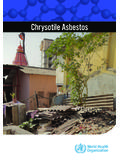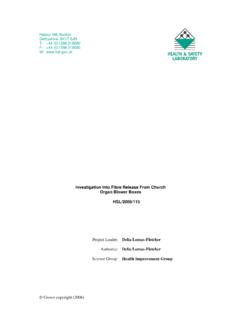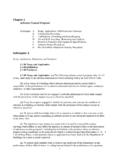Transcription of Control of Asbestos Regulations 2012 - Health and …
1 - 1 - Control of Asbestos Regulations 2012 - General enforcement guidance and advice Open Government status: Open Target audience: HSE Inspectors and Local Authority Enforcement Officers Table of contents Summary .. 1 Introduction .. 1 Action .. 2 General application of EMM to Asbestos .. 2 The categories of Asbestos inspection .. 4 1. Management of Asbestos in premises .. 4 2. Non-licensed Asbestos work: enforcement indicators .. 8 3. Notifiable non-licensed Asbestos work enforcement indicators .. 12 4. Licensed Asbestos removal work enforcement indicators .. 14 Handling enquiries on inadvertent exposure to Asbestos .. 19 Background .. 19 Summary of main provisions in the Regulations and associated ACOPs .. 19 Organisation .. 22 Further references .. 22 Summary This Operational Guidance provides advice to HSE inspectors and Local Authority enforcement officers on interpretation of the Control of Asbestos Regulations 2012 (CAR 2012 ) including enforcement benchmarks for licensed and non-licensed Asbestos work and the management of Asbestos in buildings.
2 It also includes information on inspection Introduction The Control of Asbestos Regulations 2012 , together with ACOP L143 Managing and working Asbestos [1] set out the framework for controlling exposure to Asbestos and managing Asbestos in buildings. 2 A revised version of ACOP L143 was published at the end of 2013. This incorporates the previous publication of ACOP L127 (The management of Asbestos in non-domestic premises) and takes account of the 2012 Regulations . The revised ACOP was published as part of the overarching review of ACOPs which was conducted under the L fstedt Review. Action General application of EMM to Asbestos Due to the long latency of Asbestos -related diseases, an inspector cannot take account of an individual worker s susceptibility since this will not be known. Therefore, an approach based on the most credible Health outcome is necessary.
3 The resultant enforcement outcome should be preventive, aimed at dealing with the particular situation confronting the inspector, who may not know the details of a worker s previous exposures or likely future changes to exposure patterns. In weighing up the quality of evidence available, inspectors will use their judgement about the nature of the exposure to risk and where necessary seek advice and support from Specialists, HSL, relevant Directorate Units. [2] Exposure to Asbestos can lead to a number of diseases, including asbestosis or fibrosis (scarring) of the lungs; lung cancer and mesothelioma. These diseases are irreversible, disabling and in most cases eventually fatal, and therefore come into the descriptor 'serious Health effect'. This is comparable with the safety equivalent of risk of serious personal injury.
4 Exposure to Asbestos accounts for more occupationally related deaths than any other single cause. Likelihood of developing the disease is affected by several factors - the type of Asbestos fibre; age when a worker is first exposed; the quantity of fibres breathed in; duration and frequency of exposure. The risk matrix below sets out the four exposure likelihood types that lead to serious Health effect : Asbestos risk matrix Application / Interpretation Exposure Likelihood Probable Possible Remote Nil / Negligible SERIOUS Health EFFECT Asbestosis Lung Cancer Mesothelioma Exposures to multiples of the Control limit Exposure above the Control limit likely Control limit for amphibole forms [1] and for chrysotile [2] Benchmark [3] 3 Notes in risk matrix 1. Based on 5 years exposure (typical worker aged 30-35) 2.
5 Risks from chrysotile exposure have been shown to be less than for amphibole forms but are still to be deemed remote at the Control limit. This takes into account: o Compliance requires reduction of exposure so far as is reasonably practicable and below Control limit. o HSE's position statement on Asbestos that aims to promote awareness of the risks of casual exposure and to encourage the adoption of a more precautionary approach by industry 3. The Law requires the prevention of exposure to Asbestos , but where it is not reasonably practicable to prevent exposure, exposure has to be reduced to the lowest level reasonably practicable. The employer must choose the most effective methods or combination of methods that minimise fibre release and thereby reduce exposure to below the Control limit; in addition suitable RPE must be worn.
6 The RPE must reduce exposure as low as reasonably practicable below the Control limit. For most Asbestos related work, the benchmark should be a 'nil or negligible' likelihood of serious personal injury. This is based on all necessary Control measures being in place and working such as: suitable enclosure; correct equipment - cleaned and in good working order; most appropriate techniques well planned and executed wet removal; employees wearing suitable RPE which has been properly selected including face fitting; adequate information, instruction, training and supervision; and suitable decontamination procedures in use to prevent spread etc. CAR 2012 requires prevention of exposure or reduction to the lowest level reasonably practicable. In practice, this means that the risk gap will be either substantial or extreme when work is carried out at or above the Control limit.
7 Where there is a risk of serious Health effects, from uncontrolled or poorly controlled exposure to Asbestos then inspectors should consider issuing Prohibition Notices. Exposures to Asbestos can be considered as potentially leading to a serious Health effect as set out in OC130/5 [2]. This is equivalent to serious personal injury and needs to be present for a PN. The risk identified is usually the risk of cancer . The matters giving rise to the risk are uncontrolled or poorly controlled work that may give rise to exposures above the Control limit. Inspectors should assess the controls used and whether they are sufficient to reduce exposure. It is sufficient to identify potential risk from the absence of controls that would be required to reduce exposure below the Control limits. A PN is to prevent risk of serious Health effect, regulation 11 and 16 are the key.
8 Remember that respiratory protection will only protect the wearer and there may be others at risk. 4 Where a PN is served prosecution should be considered in line with EMM figure 3. Table of EMM suggests an initial enforcement expectation (IEE) of issuing an Improvement Notice for both substantial and extreme risk gaps, and consideration of a prosecution in the case of an extreme gap. Where there is an extreme risk gap and the standards are either defined or established, prosecution should be considered in line with the EMM figure 4. Whilst this approach guides inspectors to a firm enforcement line on risks from exposure to Asbestos , it should be remembered that some breaches remain administrative in nature (see EMM Table ), such as the failure to have carried out an assessment; lack of records of RPE or equipment maintenance.
9 These are key parts of the management arrangements and are good indicators of the level of compliance, but their absence in isolation does not demonstrate a serious Health risk . If there is no risk assessment, while this may be a compliance issue, it would be difficult for an employer to show that they have an adequate POW and Control regime. In this case, inspectors should scrutinise controls, equipment and work practices to ensure risks are adequately controlled. Ancillary hazards such as risk of fall from height or working in confined space may need also to be assessed and Control measures implemented. In all cases inspectors need to make a judgement on how far the dutyholder has missed the benchmark. All Regulations and where the ACOP gives the dutyholder specific instruction are considered as defined compliance standards.
10 Otherwise guidance sections of the ACOP and HSG and INDG series publications are considered to be Established compliance standards for the purposes of Enforcement Management Model (EMM). The following sections list the key aspects of Asbestos inspection work. Each section provides specific enforcement indicators for that type of work to show what compliance should look like in practice. Note: Local Authority Enforcement officers should be aware that Asbestos has not been identified as an activity / sector suitable for proactive inspection by local authorities *except where local intelligence indicates poor performance at which point a decision should be made as to the most appropriate form of intervention. * This will denote a reference to a periodically updated list of activities/sectors for proactive inspection by LAs this list is currently out for consultation as part of the National LA Enforcement Code consultation and will be available via the HSE website.















